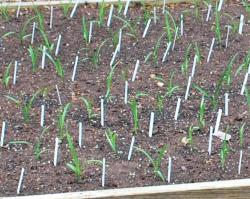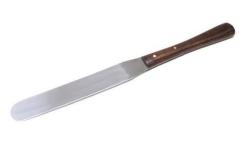Gerry – The seeds are stored in the ‘crisper drawer’ of a refrigerator from a couple of days after I harvest them until I am ready to germinate. It is only if there is a seed that I want to grow the coming spring that happens to germinate in the refrigerator that I will plant it and do what I can to get it sunlight.
Amber – I think a better estimate of the average time the seedlings are in the cells is closer to 4-6 weeks with a few a little longer and a few a little less. As for size for final planting, here is a picture of the morning after I planted my seedlings this year. (Sorry, the picture is at the bottom of the post)
The garden markers are 6 inch with about 2 inches below ground level, so seedling size is 6-8 inches, but more importantly, the third or more typically the fourth leaf (after the initial spike) is well grown.
Concerning fertilization, I start with a bed into which I have tilled a lot of pine fines along with alfalfa pellets and Milorganite a month or more before planting the seedlings. After planting, I will continue to fertilize with full strength liquid (per label directions) every two weeks. I stop doing this when our daytime temperature reaches a consistent 90+ because I don’t want to encourage too much growth during the time that watering can’t supply all the water the young plants would need if fertilized during our 3-4 month summer. I resume fertilizing when the summer heat breaks and we have several beautiful weeks of weather in October. I stop by the end of October so the plants can return to normal growth rates before the true winter weather hits after the first of the year. In late February/early March I fertilize all of my daylilies with a 1-2 tablespoons (depending on plant size) of something like a 1-2-3 ratio fertilizer that gets the root system up and running again. Then, from late March to bloom season, they all get a weekly foliar spraying of a “bloom booster” type fertilizer. This last step with the liquid is new to me this year and was suggested by grower farther south than me and I can say that it did increase branching and bud count on many of my older seedlings.
I remove and plant the germinated seed as soon as I see the white nub (I think it is called the ‘radicle’) emerge from the seed. I know others wait until the green appears, but I don’t. The Rootrainer system gives you the material which you fold to make the eight sets of cells, a hanger that they will sit on and a clear plastic cover. You furnish the potting soil/soilless mix. Re-useable? The answer is “Yes, but…” I have not broken a cell in the two years I have used them, but I try to be careful with them. If you will only be planting a few seeds. I might suggest peat pots or other fiberous pots where you can just plant the whole pot and let it decompose in the ground. That would be easier and the cost shouldn't be excessive. I stored my Rootrainers folded into the cell shape and I think they retain that shape better that way. The ends do not lock together well even when new, and they get a little worse with age. The real problem for me is getting the seedling out without disturbing the root/soil. Although the soil broke apart leaving the root with only half the soil on several occasions the first year, this year I used a spatula like you might have used in chemistry lab back in high school which helped greatly. My procedure for that is to lay the row of cells on the side and open it, slip the blade of the spatula between the inner wall of the cell and the root/soil ball, lift the seedling and carry it to the hole and tilt it into the hold while it is still on the spatula. Then remove the spatula and fill in with soil to get the plant upright.
I water from the top morning and evening while the seedlings are still in the cell. The bottom of the cell is open so it would probably be easy to water from the bottom using what I have called the cover under the rack of 32 cells. For me, however, with thunderstorms or rainy spring days, I would rather keep the covers as lids so I can keep the very heavy rains from falling directly on the plants while they are still small. Of course, we have strong winds with our thunderstorms, so I have to put a rock or something heavy on top of the covers to keep them in place.
For your final question, you are correct, the seedlings are quite mixed up among the various trays when I am finished germinating. That is why I have entered each seedling in a Microsoft Word table with location (tray #, row # & plant letter) and seed cross number. Any seed that does not produce a green seedling as well as any defective seedling has been removed from the list. I then sort the table using Microsoft by the cross number (see my preceding post). When I sort the tables by cross number (and use the date as a secondary sort) I get a list of each of the seedling for each seedling cross and that list shows locations for each seedling of each cross. Yes, its still takes time and patience, and considerably more of both as the number of crosses increases.
Based on my experience, I would suggest that if you aer interested in the Rootrainer, you only purchase one or two of them and see how you like them before committing the money necessary to buy enough for many more seedlings. They are not perfect by any stretch of the imagination. They do save on potting soil and on space, but there is nothing gained by using them if you fine you do not like them. Also, if you do not know what a chemistry lab spatula look like, I am attaching a picture of the type I use. You would need a blade at least 6" long but no wider that 1".
If there is anything I still have not cleared up, let me know.



